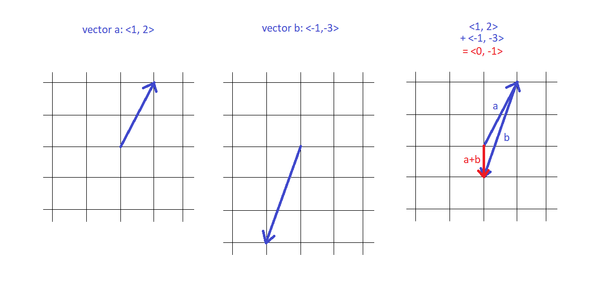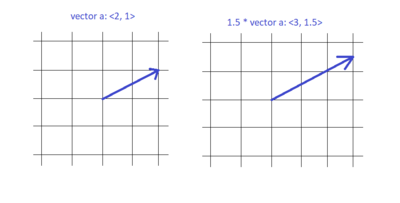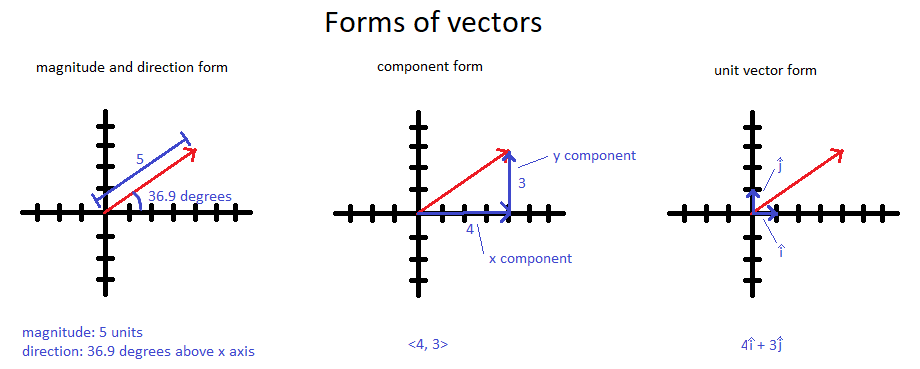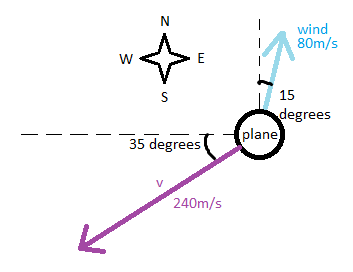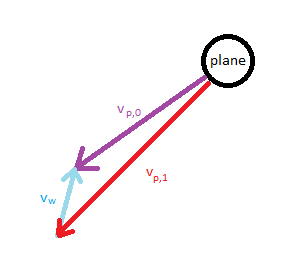Vectors
Claimed by:
ANSLEY NICHOLS (Fall 2021) BAILEY MARTIN (Fall 2020) This page defines and describes vectors.
The Main Idea
In mathematics and physics, a vector is a quantity with both a magnitude and a direction in space. The magnitude of a vector is a scalar value which can represent a variety of characteristics, depending on the situation. The magnitude of the vector (and the vector itself) has units corresponding to the characteristic it represents. The direction refers to the angle from the positive x -axis. Thus, the magnitude refers to the length and the direction refers to the angle. Note that a vector does not necessarily extend from one point in real, physical space to another; unless the magnitude is in units of length, the magnitude of the vector usually represents a property that exists at a single point in real, physical space, or at no position in particular.
A Mathematical Model
Simple Examples of Vector Quantities
To understand what it means for a vector to have both a magnitude and a direction, and to understand why the magnitude and direction together are often considered a single quantity, it can be helpful to consider an example. The Velocity of an object is an example of a vector quantity. The speed of the object, often given in meters per second (m/s), is a scalar value describing how quickly the object is moving. Speed is the magnitude of the velocity vector. However, the object's movement happens in a particular spatial direction, which the speed alone does not tell us. The direction of the object's movement is also a part of the velocity vector. Together, speed and direction comprise the velocity vector and give a complete description of an object's motion at a point in time.
Along with velocity, a person's position can be represented in vector form. Position relative to another object is found by subtracting their vector forms. Finding the magnitude of the relative position vector will find the shortest distance between the two objects. A very common use of the position vector is finding position relative to the origin. To do this, we subtract the zero vector from the position vector. This allows for easy manipulation of the position vector because it is centered at zero.
Weight is also a vector, typically with only a component in the y direction. Weight is typically represented by the force of gravity on an object. We represent the force of gravity as follows:
[math]\displaystyle{ \vec{F} = \lt 0, -mg, 0\gt }[/math]
Where [math]\displaystyle{ -mg }[/math] is the gravitational constant (9.8) multiplied by mass in kilograms. The magnitude of the vector, [math]\displaystyle{ |-mg| }[/math] is equal to the weight of the object.
Beginning Concepts
A vector is typically written as a letter with an arrow over it. For example: [math]\displaystyle{ \vec{a} = \langle 1, 2, 3 \rangle }[/math]. The arrow may one-sided to make it easier to write. Alternatively, a vector might simply be written as a boldface letter: a. Which letter is used depends on the context; for example, [math]\displaystyle{ \vec{v} }[/math] represents velocity.
A specific component of a vector (see the section titled "forms") is denoted by a subscript: cx. For example, qy represents the y component of some vector [math]\displaystyle{ \vec{q} }[/math].
Surrounding a vector by | symbols denotes its magnitude: [math]\displaystyle{ |\vec{b}| }[/math]. Alternatively, there are exists the notation [math]\displaystyle{ \overline{v} }[/math] and [math]\displaystyle{ \lVert \vec{v} \rVert_2 }[/math], with the latter denoting the Euclidean norm, which is the type of vector norm that you will see most often.
The magnitude of some vector is defined to be [math]\displaystyle{ \lVert \vec{v} \rVert_2 = \sqrt{v_x^2 + v_y^2 + v_z^2} }[/math], where the axes of the 3D-map are mathematically notated as [math]\displaystyle{ \hat{x}, \hat{y}, \hat{z} }[/math].
A unit vector is a vector whose magnitude is equal to one, and normalization is the process of setting a vector's magnitude to 1. A unit vector is denoted by a letter with a ^ symbol (called a "hat") written over it: [math]\displaystyle{ \hat{d} }[/math] (read as "d-hat"). Certain letters represent specific unit vectors. For example, [math]\displaystyle{ \hat{i} }[/math], [math]\displaystyle{ \hat{j} }[/math], and [math]\displaystyle{ \hat{k} }[/math] (alternatively, [math]\displaystyle{ \hat{x} }[/math], [math]\displaystyle{ \hat{y} }[/math], and [math]\displaystyle{ \hat{z} }[/math]) are unit vectors pointing in the +x, +y, and +z directions respectively. Non-Cartesian coordinate systems often have their own unit vectors; for example, 2D polar coordinates make use of the [math]\displaystyle{ \hat{r} }[/math] and [math]\displaystyle{ \hat{\theta} }[/math] unit vectors.
Unit vectors are defined to be for an arbitrary vector: [math]\displaystyle{ \hat{v} = \frac{\vec{v}}{\lVert \vec{v} \rVert_2} }[/math]
Visually Representing Vectors
Vectors are visually represented by arrows. The length of the arrow represents the magnitude of the vector, while the direction the arrow points in represents the direction of the vector. If a vector exists at a particular point in space, the "tail" of the arrow (the end without the V shape) should be placed at that point.
This example shows a visual representation of the velocity vector of a ball, which is moving to the right at a speed of 5m/s.
Important Vector Operations
It is possible to perform a variety of mathematical operations on vectors, both with other vectors and with scalars. These operations appear in a variety of formulas in physics. To make the operations easier to learn, they are defined below assuming all vectors to be 3-dimensional; the more general n-dimensional definitions look more confusing. If necessary, it is easy to guess how to perform each operation with n-dimensional vectors by extrapolating from the 3-dimensional case.
Addition:
[math]\displaystyle{ \vec{a} + \vec{b} = \langle (a_x + b_x), (a_y + b_y), (a_z + b_z) \rangle }[/math].
In other words, to add two vectors, simply add the vector's like components to form the new components. In order to add two vectors together, your first have to identify the tips and the tails of the vectors. Then, you take the second vector and place the tail up to the tip of the first vector. Then, you draw a connecting vector from the tail to the tip of the connected vectors. The resultant vector is the sum of the vectors.
Subtraction:
[math]\displaystyle{ \vec{a} - \vec{b} = \langle (a_x - b_x), (a_y - b_y), (a_z - b_z) \rangle }[/math].
In other words, to subtract two vectors, simply subtract their like components to form the new components.
Multiplication by scalar:
[math]\displaystyle{ k \vec{a} = \langle k \cdot a_x, k \cdot a_y, k \cdot a_z \rangle }[/math].
In other words, multiplying a vector by a scalar multiplies each of that vector's components by that scalar. Note that this only affects a vector's magnitude, not its direction, unless the scalar is negative, in which case the direction of the vector is reversed.
Division by scalar:
Division by a scalar behaves exactly like scalar multiplication. You divide each component by the scalar. You can also conceptualize this by saying that you are multiplying each component by a fraction of [math]\displaystyle{ 1/(scalar) }[/math]
[math]\displaystyle{ \frac{\vec{a}}{k} = \langle \frac{a_x}{k}, \frac{a_y}{k}, \frac{a_z}{k} \rangle }[/math].
Dot product (also called scalar product):
[math]\displaystyle{ \vec{a}\cdot\vec{b} =(a_x \cdot b_x) + (a_y \cdot b_y) + (a_z \cdot b_z) }[/math].
In other words, the dot product of two vectors is the sum of the products of their like components. The dot product of a two vector quantities is a scalar. This quantity makes it easy for us to see the relationship between two vectors in a simple, scalar quantity.
It is important to note that the dot product of two vectors has a specific value: [math]\displaystyle{ \vec{a}\cdot\vec{b} = |\vec{a}| \cdot |\vec{b}| \cdot \cos(\theta) }[/math], where [math]\displaystyle{ \theta }[/math] is the angle between the vectors.
Cross product (also called vector product):
The simplest definition, which is also the one found on the formula sheet, is:
[math]\displaystyle{ \vec{a} \times \vec{b} = = \langle (a_yb_z - a_zb_y), (a_zb_x - a_xb_z), (a_xb_y - a_yb_x) \rangle = (a_yb_z - a_zb_y)\hat{i} + (a_zb_x - a_xb_z)\hat{j} + (a_xb_y - a_yb_x)\hat{k} }[/math].
This is equivalent to the following matrix determinant, which may be easier to remember:
[math]\displaystyle{ \begin{vmatrix} \hat{i} & \hat{j} & \hat{k} \\ a_x & a_y & a_z \\ b_x & b_y & b_z \end{vmatrix} }[/math]
In order to find the determinant of a 3x3 matrix, it can be helpful to use the expansion by minors process. The below image shows how this works. You cross out the first row, and then the column corresponding to i. Then, find the determinant of the smaller 2x2 matrix created by this simplification. Perform this 2 more times with j and k, and do not forget that the j term is always subtracted!

The cross product of two vectors results in another vector. It is important to note that the magnitude of the cross product of two vectors has a specific value: [math]\displaystyle{ |\vec{a}\times\vec{b}| = |\vec{a}| \cdot |\vec{b}| \cdot \sin(\theta) }[/math], where [math]\displaystyle{ \theta }[/math] is the angle between the vectors.
The direction of the cross product of two vectors is perpendicular to the plane in which those vectors lie and is given by the Right Hand Rule. 2D vectors do not have cross products. While the other operations listed here are commutative, associative (where the associative property is defined), and distributive over addition; cross product multiplication is not associative and is anticommutative ([math]\displaystyle{ \vec{a}\times\vec{b} = -\vec{b}\times\vec{a} }[/math]), meaning that if the order of the factors is reversed, their cross product will be reversed in direction.
For more mathematically-advanced students, I will invoke some higher-level linear algebra. Recall that the null space, defined as [math]\displaystyle{ Null(A) = \{ \vec{v} \in \mathbb{R}^n \mid A\vec{v} = \vec{0} \} }[/math] for an arbitrary matrix [math]\displaystyle{ A \in \mathbb{R}^{n \times n} }[/math], is orthogonal, or normal, to its row space. That is, for all [math]\displaystyle{ \vec{v} \in Null(A) }[/math] and for all columns [math]\displaystyle{ a_{j:} }[/math], we have [math]\displaystyle{ \sum^n_{i=1} a_{i,j} v_i = 0 }[/math].
For two vectors [math]\displaystyle{ \vec{a},\vec{b} \in \mathbb{R}^{3 \times 1} }[/math] (note that this is only valid for 3x1 vectors), if we think of [math]\displaystyle{ \vec{a} }[/math] as corresponding to a row in a matrix and [math]\displaystyle{ \vec{b} }[/math] to another, then the null space is equivalent to their cross-product. This is why the right-hand rule works. If we visualize the plane spanned by two vectors with our index and middle fingers, then their null space will be perpendicular to the intersection point of the two vectors, or rather the thumb. Likewise, if we use all of our fingers and our thumb to make an L-shape representing the span of the two vectors, upon curling our fingers, we will have the direction of the cross product, which is orthogonal to the two vectors represented by your thumb and fingers.
Forms
The information necessary to describe a specific vector can be presented in several forms.
Magnitude and direction form
In this form, the magnitude and the direction of the vector are explicitly stated. The statement describing direction might be a cardinal direction (ex. "north"), a direction on a graph (ex. "the +x direction"), or an angle (ex. "210[math]\displaystyle{ ^\circ }[/math] from the x axis counterclockwise"), depending on the situation. Magnitude and direction form is often used in word problems because it is easy for humans to understand. This also makes it easier to measure vectors in real world applications. When building structures, it is much easier to say that you want a 5 foot plank of wood 60[math]\displaystyle{ ^\circ }[/math] off of the ground.
Component form
In this form, the vector is divided into components, each representing a different coordinate direction. In 2D space, these are the x and y directions. In 3D space, these are the x, y, and z directions. Each component tells how much the vector extends in that particular direction. Often, the three components are written enclosed by angle brackets and separated by commas. For example, the vector [math]\displaystyle{ \lt 2,0,-3\gt }[/math] describes a vector that extends 2 units in the [math]\displaystyle{ \hat{+x} }[/math] direction, 0 units in the [math]\displaystyle{ \hat{y} }[/math] direction, and 3 units in the [math]\displaystyle{ \hat{-z} }[/math] direction. Most vector operations described below can only be performed if the vectors are in component form, so this form may be necessary to do math for certain problems. Furthermore, programming languages store vectors in component form.
Unit vector form
In this form, the vector is expressed as a sum of unit vectors, each corresponding to a different coordinate direction. The symbols [math]\displaystyle{ \hat{i} }[/math], [math]\displaystyle{ \hat{j} }[/math], and [math]\displaystyle{ \hat{k} }[/math] OR the symbols [math]\displaystyle{ \hat{x} }[/math], [math]\displaystyle{ \hat{y} }[/math], and [math]\displaystyle{ \hat{z} }[/math] are used to represent unit vectors in the x, y, and z directions respectively. Consider the vector <2,0,-3>. It can be expressed in unit vector form as [math]\displaystyle{ 2\hat{i} - 3\hat{k} }[/math], meaning 2 times the x direction unit vector minus 3 times the z direction unit vector (see vector operations). While often considered its own form, unit vector form is very similar to component form, as the information describing the vector is stored in the same values. All references to component form in the rest of this page also apply to unit vector form.
Note that regardless of which form is used, an n-dimensional vector requires n values to mathematically describe. For example, consider a 3-dimensional vector. Describing this vector in component form requires an x value, a y value, and a z value. Describing it in magnitude and direction form requires one value to give the magnitude of the vector and two to give the its direction (the direction of a 3D vector could be described using, say, its polar angle [math]\displaystyle{ \theta }[/math] and its azimuthal angle [math]\displaystyle{ \phi }[/math]). A 1-dimensional vector (such as the velocity of a particle whose movement is constrained to the x axis) can be described using only 1 value whose sign indicates the vector's direction.
Converting between forms
It is possible to convert vectors from one form to another using simple trigonometry.
To find the magnitude of a vector in component form, use the Pythagorean theorem: add the squares of the components and take the square root of the result. For a 2D vector, [math]\displaystyle{ |\vec{a}| = \sqrt{a_x^2 + a_y^2} }[/math].
To find the direction of a vector in component form, use inverse trigonometric functions. For a 2D vector, [math]\displaystyle{ \theta = \tan^{-1}(\frac{a_y}{a_x}) }[/math], where [math]\displaystyle{ \theta }[/math] is the angle vector [math]\displaystyle{ \vec{a} }[/math] makes with the x axis in the counterclockwise direction.
To find the components of a vector in magnitude and direction form, use trigonometric functions. For a 2D vector, [math]\displaystyle{ a_x = |\vec{a}|\cos\theta }[/math] and [math]\displaystyle{ a_y = |\vec{a}|\sin\theta }[/math], where [math]\displaystyle{ \theta }[/math] is the angle vector [math]\displaystyle{ \vec{a} }[/math] makes with the x axis in the counterclockwise direction.
A Computational Model
In VPython, vector objects are in component form; each one has an x, y, and z component. Recall that in VPython, using the default camera orientation, the +x axis points to the right, the +y axis points upwards, and the +z axis points out of the plane of the screen towards the viewer. The constructor for a vector object is the word "vec" or "vector," and it takes three arguments, which define its x, y and z components respectively. A line to create a vector called "velocity" might look like this:
velocity = vec(3,-1,2)
To access or modify a specific component of a vector object, its name should be followed by a period and an x, y, or z. For example, to change the x component of the above velocity vector from 3 to 5, the following line might be used:
velocity.x = 5
In VPython, vectors have many uses. The position of each object is defined as a vector; the position vector's tail lies at the origin and its head lies at the center of the object in question. Furthermore, the dimensions of a rectangular prism (a "box" object) are defined as a vector; the x component determines its width, the y component its height, and the z component its thickness.
To graphically represent a vector such as an electric field, "arrow" objects should be used. In addition to taking a position vector (which determines the position of the arrow's tail), arrow objects take an "axis" vector, which determines their size and shape. To represent a vector, simply make it the axis of an arrow object.
Click Here to run the interactive computational model This computational model breaks each vector operation down. It begins with defining the vector, and then goes into different vector operations. These operations are broken into both their written formula and the Glowscript shortcut function. Play around with the numbers and vector definitions to see what happens! It begins by defining the vectors as arrows, and that's all you need to play around with the different functions! You may also want to comment out some of the sections, so you can see how each function works individually.
Examples
Very Simple
Vector [math]\displaystyle{ \vec{a} }[/math] is <2.5, 7.4, 8.0>. What is the magnitude and direction of Vector A?
Solution:
First, we must find the magnitude.
[math]\displaystyle{ |\lt 2.5, 7.4, 8.0\gt | = \sqrt{2.5^2 + 7.4^2 + 8.0^2} }[/math]
[math]\displaystyle{ = \sqrt{6.25 + 54.76 + 64} }[/math]
[math]\displaystyle{ = \sqrt{125.01} }[/math]
[math]\displaystyle{ = 11.18 }[/math]
Now, we must find the direction by finding the unit vector.
[math]\displaystyle{ unit vector = \vec{a} / mag(a) }[/math]
[math]\displaystyle{ x = 2.5/11.18 = .224 }[/math]
[math]\displaystyle{ y = 7.4 / 11.18 = .662 }[/math]
[math]\displaystyle{ z = 8.0 / 11.18 = .716 }[/math]
[math]\displaystyle{ direction = \lt .224, .662, .716\gt }[/math]
Simple
Vector [math]\displaystyle{ \vec{a} }[/math] is <2,4,2>. Vector [math]\displaystyle{ \vec{b} }[/math] is <-1,1,3>. What is the magnitude of the vector [math]\displaystyle{ \vec{a} - 2\vec{b} }[/math]?
Solution:
[math]\displaystyle{ \vec{a} - 2\vec{b} = \lt 2,4,2\gt - 2 * \lt -1,1,3\gt }[/math]
[math]\displaystyle{ = \lt 2,4,2\gt - \lt -2,2,6\gt }[/math]
[math]\displaystyle{ = \lt 4,2,-4\gt }[/math]
We are asked to find the magnitude of this vector, so let us use the Pythagorean theorem with its components:
[math]\displaystyle{ |\lt 4,2,-4\gt | = \sqrt{4^2 + 2^2 + (-4)^2} }[/math]
[math]\displaystyle{ = \sqrt{16 + 4 + 16} }[/math]
[math]\displaystyle{ = \sqrt{36} }[/math]
[math]\displaystyle{ = 6 }[/math]
Intermediate
An airplane is travelling in still air at 240m/s in the direction 35[math]\displaystyle{ ^\circ }[/math] south of west. A wind begins to blow; the wind has a speed of 80m/s in the direction 15[math]\displaystyle{ ^\circ }[/math] east of north. What should be the new velocity of the plane relative to the air around it to maintain its original trajectory? You may give your answer in component form (+x is east, +y is north).
Solution:
The vector sum of the new velocity of the plane [math]\displaystyle{ \vec{v_{p,1}} }[/math] and the velocity of the wind [math]\displaystyle{ \vec{v_w} }[/math] should equal the original velocity of the plane [math]\displaystyle{ \vec{v_{p,0}} }[/math] (see Relative Velocity):
[math]\displaystyle{ \vec{v_{p,1}} + \vec{v_w} = \vec{v_{p,0}} }[/math]
[math]\displaystyle{ \vec{v_{p,1}} = \vec{v_{p,0}} - \vec{v_w} }[/math]
Let us convert the given vectors to component form for easier subtraction. The +x and +y directions will be east and north respectively.
[math]\displaystyle{ \vec{v_{p,0}} = \lt 240\cos(215^\circ), 240\sin(215^\circ)\gt }[/math]m/s (35[math]\displaystyle{ ^\circ }[/math] south of west is 215[math]\displaystyle{ ^\circ }[/math] above the x axis)
[math]\displaystyle{ \vec{v_{p,0}} = \lt -196.6, -137.7\gt }[/math]m/s
[math]\displaystyle{ \vec{v_w} = \lt 80\cos(75^\circ), 80\sin(75^\circ)\gt }[/math]m/s (15[math]\displaystyle{ ^\circ }[/math] east of north is 75[math]\displaystyle{ ^\circ }[/math] above the x axis)
[math]\displaystyle{ \vec{v_w} = \lt 20.7, 77.3\gt }[/math]m/s
Now let us subtract:
[math]\displaystyle{ \vec{v_{p,1}} = \vec{v_{p,0}} - \vec{v_w} }[/math]
[math]\displaystyle{ \vec{v_{p,1}} = \lt -196.6, -137.7\gt - \lt 20.7, 77.3\gt }[/math]m/s
[math]\displaystyle{ \vec{v_{p,1}} = \lt -217.3, -214.9\gt }[/math]m/s
Difficult
What is the angle between the vectors <2,5,-2> and <3,-4,-1>?
Solution:
The dot product between two vectors is equal to the product of their magnitudes times the cosine of the angle between them. Let us use this property to find the angle between the given vectors.
[math]\displaystyle{ \lt 2,5,-2\gt \cdot \lt 3,-4,-1\gt = |\lt 2,5,-2\gt | * |\lt 3,-4,-1\gt | * \cos\theta }[/math]
Rearranging this yields
[math]\displaystyle{ \theta = \cos^{-1}\frac{\lt 2,5,-2\gt \cdot \lt 3,-4,-1\gt }{|\lt 2,5,-2\gt | * |\lt 3,-4,-1\gt |} }[/math]
Let us evaluate the dot product and simplify:
[math]\displaystyle{ \theta = \cos^{-1}\frac{2(3) + 5(-4) + (-2)(-1)}{\sqrt{2^2 + 5^2 + (-2)^2} * \sqrt{3^2 + (-4)^2 + (-1)^2}} }[/math]
[math]\displaystyle{ \theta = \cos^{-1}\frac{-12}{\sqrt{33 * 26}} }[/math]
[math]\displaystyle{ \theta = 114^\circ }[/math]
Connectedness
Vectors play a part in almost every part of our lives. For example, the desk you are probably sitting at was built by using vectors. A force vector is used to represent things like the force of gravity (0, mg, 0), vectors to represent how the pieces within the desk are exerting forces on each other, and a vector to represent the force of the floor on the desk. This just scratches the surface of the vectors that can represent a desk. Any measurement taken, for example the diagonal across the desk, can be represented as a vector.
Another example of vectors in everyday life is how they can represent how we move. Your position can be represented as a vector relative to any other spot in the universe. To find your relative position vector, you take your position vector and subtract the other vector from it. Velocity can also be represented in vector form. When yo move, you have a certain velocity in each direction, so it can be represented in vector form. This can also be found by taking the derivative of the position vector with respect to time. The velocity vector can also be integrated to find the position vector. The magnitude of the velocity vector is equivalent to the speed that one is travelling. Acceleration can be represented by taking the derivative of the velocity vector. Each of these vectors can be broken into their components to be able to see how you are traveling in each direction.
Vectors are a very important part of most physics 2 material. Nearly every quantity we are looking for is represented as a vector. Electric field, Magnetic field, all of the forces, and many other things. For example, the Magnetic Force on a point particle is represented as follows:
[math]\displaystyle{ {\vec{F} = q\vec{v}\times\vec{B}} }[/math]
This uses both the cross products of 2 vectors and multiplying that cross product (a vector) by a scalar. Vector knowledge is very important in Physics 2, as it is the basis for nearly everything we do.
Most scientific disciplines don't rely as heavily on vector forms as Physics. Because physics is so focused on the motion of different things (people, particles, objects), vectors are an integral part of Physics. Even planets move according to patterns describes by vectors. Every physical quantity, no matter how big or small, can be represented in vector form.
History
It is unknown who first developed the idea of vectors, but the oldest known reference to vectors is in the work Mechanics by Hero of Alexandria (first century AD), which described their addition. At this point, however, the idea of a vector was little more than a line segment with a specific orientation; they had a length extending from one point in physical space to another but were not used to represent anything else.
In the early 19th century, several mathematicians and physicists (including Caspar Wessel (1745-1818), Jean Robert Argand (1768-1822), Carl Friedrich Gauss (1777-1855)), and William Rowan Hamilton (1805-1865) used 2D vectors to represent complex numbers; one component would represent the real value and another would represent the imaginary value. Hamilton would also become the first to use the word "vector." August Ferdinand Möbius (1790-1868) contributed to vector math in his 1827 book The Barycentric Calculus, in which he developed the convention of labeling vectors with letters and defined the multiplication of a vector by a scalar. Hermann Grassmann (1809-1877) wrote in his 1844 book Ausdehnungslehre (German for "The Calculus of Extension") that vectors could exist in space of any number of dimensions and described much of what would become linear algebra, which makes ample use of vectors.
The modern language and conventions surrounding vectors come largely from notes created by J. Willard Gibbs (1839--1903), a professor at Yale University.
See also
External links
Mathematical Computations on Vectors: [http://ocw.mit.edu/courses/mathematics/18-02sc-multivariable-calculus-fall-2010/1.-vectors-and-matrices/part-a-vectors-determinants-and-planes/session-1-vectors/MIT18_02SC_notes_0.pdf
Computational Work with Vectors: http://vpython.org/contents/docs/vector.html
Basics of Vectors: https://www.physics.uoguelph.ca/tutorials/vectors/vectors.html
Further Reading
Vector Analysis by Josiah Willard Gibbs
Introduction to Matrices and Vectors by Jacob T. Schwartz
References
https://www.mathsisfun.com/algebra/vectors.html
http://mathinsight.org/vector_introduction
http://www.math.mcgill.ca/labute/courses/133f03/VectorHistory.html

